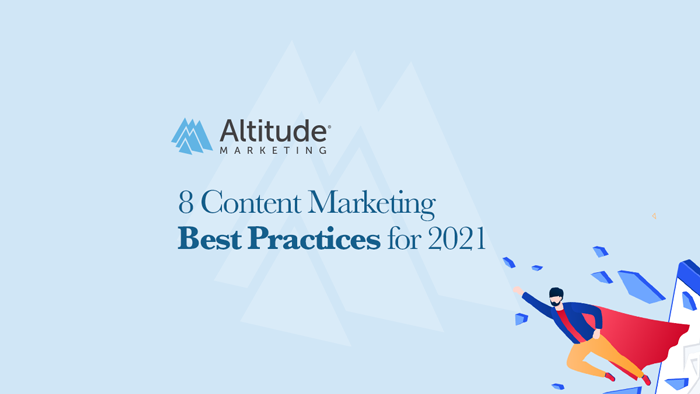Content is an increasingly popular way to reach B2B buyers. And that means it’s important to get a handle on content marketing best practices.
The watchword for B2B content marketing in 2021 is the prospect.
After all, it’s easy to approach a content marketing strategy with yourself in mind. You think about what you want to get to the market and what you want to say and what your product offerings are and why people should buy from you.
Notice how many times we used the word “you?”
The point is, making your content about you defeats the purpose. Your prospect – and eventual buyer – wants an answer to a question, not a thinly veiled sales pitch.
If you’re not delivering what they want, or worse, try to trick them, your content marketing isn’t going to help you.
So let’s keep the prospect front of mind as we look at our 2021 B2B content marketing best practices.
B2B Content Marketing Best Practices for 2021
- Be Flexible
- Use Analytics (the Right Way)
- Write More
- Treat Prospects Like Adults
- Think About Timing
- Don’t Go Overboard with Research
- Promote Smartly
- Think Holistically

Best Practice #1: Be Flexible
It’s important to have a plan. It’s important to have an overarching strategy, and it is important to know what you’re trying to do and who you’re trying to reach. But if you have an intractable plan or marketing strategy, you’re in trouble.
Content marketing, at the end of the day, is a digital play. And the best digital players have changed over time. The places where people want to consume information and news and have their problems answered have all morphed dramatically as buyer behavior has changed.
If you can’t adapt, you can’t compete. Simple as that.
Look at what Twitter and YouTube and the ESPNs and CNNs have done over the years. They’ve all learned to adapt to the ways people are consuming content.
And if you can’t adapt, you can’t compete. Simple as that.
On an individual level, content marketers need to change, too. If something isn’t working and resonating with targets, something needs to change. If certain content isn’t ranking, you probably need to be producing different kinds of things.
Flexibility is so, so key.
We’re not saying you should change tack every week, but it never hurts to look at what you’re doing and see how you can do it better.
Best Practice #2: Use Analytics (the Right Way)
Be careful with content marketing analytics.
It’s easy to obsess over metrics. You’re proud of that blog post you spent five hours writing – and that’s fair! But the fact of the matter is, in terms of analytics, any number below 10,000 is essentially zero.
If you don’t have a widely read site, you probably aren’t going to be able to draw a whole lot of good, specific information from a single post or a single page. You have to look at the big picture of your content marketing efforts.
In fact, a true content marketing strategy will often create results that seem really really bad on Google Analytics.
Why?
If you start posting useful content to your blog 3-5 times a week, you’re going to get a lot of users who want their questions answered. And they may not necessarily drive into your sales funnel. They’re probably going to drive your bounce rate up past 80%.
Don’t freak out!
If you have a quantity-focused B2B content marketing strategy for 2021, your pages per session will go down and your bounce rate will go up. But it’ll also help you rank for the keywords you really want.
Best Practice #3: Write More
Here’s an important content marketing best practice: Write more. Do more. Produce more.
How much should you be writing to support your content marketing strategy?
Whatever feels unrealistic or just “too much,” shoot for that.
At the end of the day, you want to be an industry leader.
An industry leader would answer a whole lot of questions about their industry.
That means producing a lot of content.
Sure, it’ll make your analytics look a little funny. But think about two equivalent sites with equivalent authority and an equivalent home page. One has 1,000 blog posts posts answering a lot of questions about the topic. The other has zilch. Which will rank for the best keywords? The content-dense one – every time.
Moral of the story here: Quantity is key.
When it comes to content marketing, just do more.
And do more after that.
Best Practice #4: Treat Prospects Like Adults
Look at your content marketing efforts with a critical eye. Look at that CTA you stuck at the end of the blog post. Or that clickbait headline you chose. Or that half answer you gave.
Ask yourself: Would this convince me?
In many cases, no.
We’ve all seen those cringe CTAs and thinly veiled sales pitches. News flash, they’re not as convincing as you may think they are.
People can tell. You’re just trying to trick them.
Actually be genuine, actually provide information, and if the reader likes what they see, they’ll reach out to you. But don’t force it.
Just be human. How’s that for a content marketing best practice?
Best Practice #5: Think About Timing
There’s a reason that this post is about B2B content marketing best practices for 2021.
While it’s great to think long-term with your content strategy, understand that you’ll be changing it constantly.
Things are changing very rapidly. Strategies need to change every year – every month even.
While it’s great to think long-term with your content strategy, understand that you’ll be changing it constantly. If it’s not a couple times a year, it’s at least once a year.
“Evergreen” content is great because it’s nice when things are the same. You’ll have some of it. Just know that you’ll be producing new stuff frequently, and probably changing tacks all the time.
You have to adapt in order to play the content marketing game.
Best Practice #6: Don’t Go Overboard With Research
You read about research a lot in posts about content marketing best practices. And although some research is good, too much research is a really bad thing.
Here’s why.
Say you’re writing a blog post about a topic in your industry. You soon find yourself in a Wikipedia hole, and end up with the equivalent of a 12-page bibliography.
That sounds impressive. But really, it means you’re writing about the wrong thing.
If you need someone else to tell you about a topic before you can write about it, you’re not the authority on the subject. They are.
Google will rank their stuff higher. And readers will appreciate it more. Plus, your post is giving them – the SEO competition – the linkback and the authority.
If all you’re doing is aggregating information from a handful of different websites, why not write about stuff you actually know instead?
Instead, stick with what you know best and write about it. You’re probably a subject matter expert in a topic that someone else isn’t. Use that to your advantage.
If there’s specific stats you want to cite, that’s totally fine. But if all you’re doing is aggregating information from a handful of different websites, why not write about stuff you actually know instead?
Also, if you’re researching for hundreds of hours on end to learn about a different topic, that’s hundreds of hours worth of content you could have written about things near and dear to you.
After all, time is money.
Best Practice #7: Promote Smartly
Three years ago, you’d go on Twitter, LinkedIn, and Facebook and boost posts to a wide audience for a couple of bucks. Super easy stuff.
But things have changed due to the pandemic.
Everyone lost their trade shows, and the associated leads. They automatically had a bunch of money to throw around for lead generation. And a lot of marketers went the easy route, throwing cash at the social networks.
That increased CPCs by 30-40% – at least.
And that means boosting your posts isn’t as cost-effective as it used to be. Granted, if you have something really worthwhile, it doesn’t hurt to boost it on one of those networks. However, if you do something outside of what everybody else is doing, you can find some pretty sweet deals for yourself.
When it comes to content marketing best practices for 2021, think outside the box in terms of how you promote things.
You can look at native content by using Outbrain, Choozle, or Taboola. Organic social posting can be powerful. Quick-turn videos can rack up thousands of views, fast. Simple, easy, homegrown stuff is honestly the way to go.
When it comes to content marketing best practices for 2021, think outside the box in terms of how you promote things.
It’s not just about going on social platforms and boosting posts anymore.
Best Practice #8: Think Holistically
Your content marketing may produce results that aren’t 100% attributable to it. That’s fine.
It’s pretty rare for someone to point to your blog and say “Can I work with you now?” As awesome as that would be – and it could certainly happen – content marketing is more about providing helpful information to your prospects and establishing lead generation.
So, again, don’t get bogged down in the analytics. “How many leads did this post bring in?” is the wrong question to ask.
Instead, ask yourself: Is this helping the users we want to help?
Is it providing value to the people who we want to give us money?
If the answer is yes, you have a pretty strong hold on your B2B content marketing best practices for 2021.
Which makes us happy.
tl;dr: 2021 B2B Content Marketing Best Practices
Content marketing is always changing – especially during these turbulent times. If you’re looking to keep up with your content marketing in the new year, be sure to follow our eight B2B content marketing best practices for 2021.




